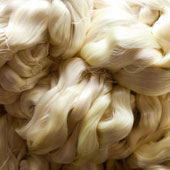Mysore Silk
Weaving Process:
The company just recently imported machines from Japan. German machines were used before that and were replaced 5 years ago. The power looms are divided into two types:
Jacquad loom
Dobby loom
The looms are supplied with patterns by the design section that are fed into the machine to weave designs onto the sarees.
a) Jacquard Loom:
These looms are powerful and require years of experience of the labourers to handle them. They have a 600-700 yarn capacity. The patterns are repeated and need to be monitored to see if any thread gets loose or cut. Each saree takes about 4 hours on the machine and generate big borders of gold on both sides of the saree.
b) Dobby Loom:
A Dobby Loom is a type of floor loom that controls the whole warp threads using a device called a dobby. A dobby loom is an alternative to a treadle loom. Each of them is a floor loom in which every warp thread on the loom is attached to a single shaft using a device called a heddle. A shaft is sometimes known as a harness, but this terminology is used less by weavers. Each shaft controls a set of threads. Raising or lowering several shafts at the same time gives a huge variety of possible gaps or 'sheds' through which the shuttle containing the weft thread can be thrown.
A manual dobby uses a chain of bars or lags each of which has pegs inserted to select the shafts to be moved. A computer assisted dobby loom uses a set of solenoids or other electric devices to select the shafts. Dobby looms expand weaver’s capabilities and remove some of the tedious work involved in designing and producing fabric. Many newer cloth design techniques such as network drafting can only reach their full potential on a dobby loom.
Design-Automated:
Design-Manual:
Weeing:






































